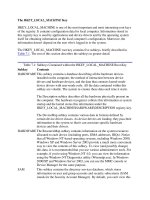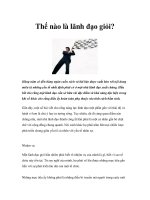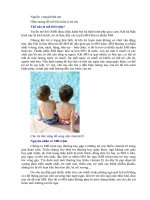Tài liệu The Bizarre Truth by Andrew Zimern ppt
Bạn đang xem bản rút gọn của tài liệu. Xem và tải ngay bản đầy đủ của tài liệu tại đây (8.65 MB, 31 trang )
Andrew Zimmern
Broadway Books • New York
Zimm_9780767931298_4p_all_r2.indd iiZimm_9780767931298_4p_all_r2.indd ii 7/23/09 8:50:24 AM7/23/09 8:50:24 AM
BIZARRE
TRUTH
How I walked out the door mouth fi rst . . .
and came back shaking my head
THE
Zimm_9780767931298_4p_all_r2.indd iiiZimm_9780767931298_4p_all_r2.indd iii 7/23/09 8:50:45 AM7/23/09 8:50:45 AM
Copyright © 2009 by Andrew Zimmern
All rights reserved.
Published in the United States by Broadway Books, an imprint of the Crown
Publishing Group, a division of Random House, Inc., New York.
www.crownpublishing.com
b r o a d w a y b o o k s and the Broadway Books colophon are trademarks of Random
House, Inc.
All photographs courtesy of The Travel Channel, L.L.C.
Library of Congress Cataloging-in-Publication Data
Zimmern, Andrew.
The bizarre truth : how I walked out the door mouth rst . . . and came back
shaking my head / Andrew Zimmern.
p. cm.
1. Food—Cross-cultural studies. 2. Food habits—Cross-cultural studies. I. Title.
GT2850.Z56 2009
394 .1’2 — d c2 2
2009027566
i s b n 978-0-7679-3129-8
Printed in the United States of America
Design by Ralph Fowler/rlf design
10 9 8 7 6 5 4 3 2 1
First Edition
Zimm_9780767931298_4p_all_r1.indd 4 7/16/09 10:46:11 AM
www.BoradwayBooks.com
Topurchaseacopyof
TheBizarreTruth
visitoneoftheseonlineretailers:
Amazon
Barnes&Noble
Borders
IndieBound
Powell’sBooks
RandomHouse
www.BoradwayBooks.com
Introduction ix
[ Going to Extremes ]
Modern Day Vikings 3
Pufn Hunting in the Land of Fire and Ice
The Most Dangerous Game 15
How I Almost Lost My Life Tracking Down
Samoa’s Elusive Giant Fruit Bat
Journey to the Source 31
Why the Shortest Distance from Sea to
Plate Makes for Amazing Meals
Muddy Waters 41
Ugandan Lung-shing Can Be Messy
[ Dying Breeds ]
The Last Bottle of Coke in the Desert 55
A Day in the Life of Tobago Cox
Saving Huatulco 66
Free Diving for Octopus
Death Match 2009 76
Can a Matador Save Madrid’s Historic Tabernas?
Forgotten Foods 86
Juicy Cheese Worms Are Making a Comeback!
Zimm_9780767931298_4p_all_r1.indd 7 7/16/09 10:46:11 AM
www.BoradwayBooks.com
[ A Few Good Meals ]
Paris 99
Best Food Day in My Life?
Welcome to a Wazwan 115
The Meal That Nearly Killed Me
Mary’s Corner 125
The Quest for the Best Laksa in Singapore
Simple Foods 140
Noodle Houses of Guangzhou
Eating My Words 147
When the Most Obvious Choice Is the Best
Fish Heaven 158
Finding Perfection in a Ginza Basement
Lamb Alley 171
Dining Nose to Tail in the Djemaa El Fna
Nature’s Candy 185
The Achachairu
Pleasant Surprises 190
A Gallimaufry
Sweat, Tears, and Blood 208
Rituals Around the World
Ritual Royalty 222
The Kalahari Trance Dance of the Bushmen
¡Viva Cuba! 241
Final Thought 265
Acknowledgments 269
Zimm_9780767931298_4p_all_r1.indd 8 7/16/09 10:46:11 AM
www.BoradwayBooks.com
Bizarre Truth? I can give you several, but one that comes to me in
my dreams at night is the idea of writing or talking, which I do for
a living, about a subject that I strongly believe is one that has to be
experienced up close and personally in order to be completely felt
or understood. Not the most ringing endorsement for a great read
or a good night spent in front of the telly. And let’s face it, empiri-
cal, experiential, immersive travel always trumps reading about
it. But we all can’t be everywhere at once, can we? And what about
music? Or sports? I guess I don’t need to play in a World Series to
appreciate baseball. Do you need to handle a guitar with the virtu-
osity of Frank Zappa or Prince to enjoy listening to music? No, you
don’t. And it is a fairly selsh conceit to try to keep all this good-
ness for myself. So I am committed to tell the tales and hopefully
accomplish several goals in the act of doing so.
Educate, entertain, inspire.
There are lots of lessons to be learned by getting out and expe-
riencing our planet. I think we live in a world where we are all
motivated by self. We live in a world that has lost touch with its
ancestry because we have grown more in every sense of the word
in the last generation than in practically all the other ones com-
bined. Gratication is instant or worthless, culture is disposable,
literature and the arts are seemingly at the bottom of an all-time
low when it comes to popularity. But this doesn’t depress me.
Frankly, I think we are simply at a pivotal swing point in our global
evolution, and when tradition, culture, and ways of thinking are
in ux they seem scary when analyzed under a microscope. But
step back and take a view from up high, peek at the big picture,
Zimm_9780767931298_4p_all_r1.indd 9 7/16/09 10:46:11 AM
www.BoradwayBooks.com
and you can see that what is happening is simply the “ebb and
ow” of civilization. Things seemed awfully bad at the fall of the
Roman Empire, didn’t they? Well, I am not in the business of pre-
dicting a new Dark Ages, but I do know this for sure. I want every-
one to take a deep breath, head out the door and see the world,
spend time with people, not stand in line at a museum. Because in
sharing ourselves with others we can learn a different way of look-
ing at who we are and how we think and act, and maybe we can
change in ways that would not be possible otherwise.
I was sitting at lunch one day in Sicily, and the thirteen-year-
old son of the sherman in whose home I was sitting and eating
got up from the table. Potty break, I gured. Nope, he was headed
off to work. On his own boat. That’s the way it still works in the
teeny town of Marzamemi on the southern coast of Sicily, near
Pachino, far from the madding crowd. The town grew around its
shing industry, with the tonneria being the guiding force in the
culture of the town. Tuna canneries in Sicily are a thing of the
past; the industry is dead and the two remaining (out of nearly
fty a generation ago) operations are doing what they can to sur-
vive. Tuna are scarce. Men wanting to spend their lives on the
water are even scarcer. But if you spent a day with this family you
could learn more about Sicilian history and the human capacities
for passion, dedication, pride, and good old-fashioned earnest-
ness than you could in any other way I can think of. You can see
how differently people live (in my country you can get arrested for
child-labor-law violation), and yet how similar we all are under
the surface circumstances of our lives. You can learn to appreciate
life and be grateful. I want my son to know these stories, meet
these people, see the world as it really is in African villages, Euro-
pean capitals, and Asian markets, because the way you learn how
to live your life is by sharing it with others. You don’t get anything
out of life by living it based on self.
So education is important, but who wants to be beat over the
head by the “pay attention” stick? Not me. So I want to entertain.
Zimm_9780767931298_4p_all_r1.indd 10 7/16/09 10:46:11 AM
www.BoradwayBooks.com
This is not intended to be revelatory in the classic sense. This is
not a textbook, nor did I intend to write a serious tome. I am not
half the writer or thinker you would need to be to accomplish that,
but I do have experiences. And that’s all it takes, quite frankly,
which is why I believe so strongly in seeing the world for one’s self.
One of the most respected anthropologists in America, the chair
of the department at a major university, once referred to me in
casual conversation as a colleague and I corrected him, saying I
was anything but. He rebuked me immediately, insisting that I
had shared more real time, on the ground, with indigenous tribes
than most tenured professors he knew. That was a wake-up call.
I quickly realized that I viewed myself one way, and that others
might see me as something else, and I could take advantage of
that, becoming an agent of change to a certain degree, perhaps an
awareness raiser for the global cultures I come in contact with.
Education comes in many forms; I am always looking for an easier
way than doing homework, but I am good at showing up for class.
That means going places and seeing what’s out there. I consider
this book a way to engage a part of ourselves that remains fasci-
nated by the human condition around the world. And I wanted it to
make you think, and laugh and be hungry when you were done
reading it. I am all about the food.
Which brings me to my thematic material. I am indeed primar-
ily focused on experiencing food and sharing culture. Why? Be-
cause I know beyond a shadow of a doubt that everyone loves a
good meal. And that food is the easiest way to bridge gaps, build
friendships, and become family . . . all in one day. I consistently
prove it again and again as I make my way through country after
country, eating my way around the world. I also believe you can
taste a culture and its people in their food. I swear to you I have
tasted struggle and love, war and death, in a good bowl of stew. I
wanted people to taste it also, and you can’t do that eating at an
Italian restaurant in Beijing. That’s not to say that you can’t nd
good veal Milanese in China, it’s just I think you should be eating
Zimm_9780767931298_4p_all_r1.indd 11 7/16/09 10:46:11 AM
www.BoradwayBooks.com
that dish in Milan if you want to really understand a cuisine and
the folks who eat it. So I wanted to give readers a sense of how I do
that, not just what I nd when I do. So I give tips, like eating at the
last stop on the subway, or investigating dying breeds, or perusing
unique and arcane ingredients, or doing some hero worship at the
altar of some great chef. Trust me; you’ll learn a lot following some
of these rules of the road. Most important, I also like to check out
spiritual systems, and as a matter of course I regularly check out
rituals wherever I can.
So why food and ritualistic traditions? Because the food always
leads to conversations, and I am always asking people what they
believe in, and why. The Greatest Questions, and ones we have been
asking ourselves for thousands of years, are what do you believe in,
why do you believe it, and what is your relationship to that belief?
The next greatest question is, of course, “rare or medium rare?”
In all seriousness, you learn things in the oddest ways. When I
was in the Kalahari, I spent some time with a local tribe outside of
Xai Xai in Botswana, and we were hunting with snap snares, one
of the trickiest ways to trap game, especially birds. We ended up
checking our snares one afternoon, and lo and behold we had a
bird in the small loop of string that the hunters had made the day
before explicitly for that purpose. They made their own string!
And they made it from stripping small plants of their bers and
winding them by hand. Anyway, when I found the teeny bird in the
trap I grabbed my knife to cut the bird down, and was stopped im-
mediately by one of the senior men in the group. “Why,” he won-
dered, “would you waste the rope by cutting it?” I was oored. I
hadn’t even thought about it and yet it was obviously the most wan-
tonly wasteful act I could imagine. I was stunned and had learned
a valuable lesson on several fronts, but the real surprise was when
we got back to camp I was told we wouldn’t eat the bird ’til the next
day because the tribe believed that the bird’s soul would alert
other birds to the traps unless we waited. And we needed those
traps to keep snaring birds. My point is that belief systems and
Zimm_9780767931298_4p_all_r1.indd 12 7/16/09 10:46:11 AM
www.BoradwayBooks.com
food are intertwined, sometimes directly, sometimes not, but you
need to pay attention. So I always try to learn everything I can
about a culture, you never know.
The majority of my travel takes place with my family and work-
mates. And most of the working experiences are the lion’s share of
my traveling, and have taken place during the taping of Bizarre
Foods and Bizarre World. Many years ago I took a meeting with the
head of a production company here in Minnesota at the urging of
a mutual friend (thanks, Robin!), and the resulting relationship
between Colleen Steward and myself birthed both of our TV shows
and several specials. The idea for our show was created at Tremen-
dous Entertainment and was the collective result of a lot of smart
and talented people over the years as we incubated, tested, and
tried to sell the idea of sending me around the world mouth rst.
It took several years, but nally the amazing Pat Younge and his
team at Travel Channel took a chance on an unknown talent and
green-lit our show.
Shannon, Mike, Chris, Patrick, Tasha, Johanna, Scott, Steve,
Gary, Luke, Joel, Tacy, Jane, Pam, Dave, Nina, Carrie, Laurel,
Ellen, Ladonna, Erik, Troy, Steve, Darrin, Kel, Libby, Nicole, Tye,
Debbie, and dozens of others worked very hard and put up with a
lot of crap from me to make this show what it is. Here is essentially
how it works.
We nd locations and set the shooting schedule for the year, we
rotate teams, researching and preproducing several shows at a
time, enlisting the help of many local producers, writers, research-
ers, and videographers on the ground in each country to help us
nd the most compelling stories. We do not seek out strange en-
claves or outrageous foods for the sake of shocking people. If we
wanted to do that, we would shoot the whole thing at the town land-
ll here in Minneapolis and save a lot of travel costs. We nd sto-
ries about real people and their cultural tradition. That’s rst and
foremost on our minds. Then we try to tell the stories from the
fringes, and that is ultimately where there are not only bizarre
Zimm_9780767931298_4p_all_r1.indd 13 7/16/09 10:46:12 AM
www.BoradwayBooks.com
habits and customs, but also the greatest number of untold stories.
It works for us. I always travel with a eld producer and two videog-
raphers. We pick up sound techs, xers, drivers, security folks, and
PAs along the way. We typically travel seven to nine people as a
crew, and we usually take seven to nine days to shoot a show in its
entirety. Primary shooting usually takes six or seven days.
I spend more time on the road with my team than I spend time
at home with my family. We are very close and have endured a lot
together, shared life and death, and faced down some pretty hairy
situations. I was in a small town in Morocco, outside a madrasa
as luck would have it, on the day that Abu Musab al-Zarqawi was
killed. My producer, cameraman, and I had to run for it, scram-
bling into the van and racing out of town. There was a lot of fear
and misunderstanding on the street that day and we got caught up
in it. That is not atypical.
My crew deserves more love and applause than I can ever throw
their way, and I am eternally grateful for their ability to work sev-
enteen hour days, day after day, and of course, they have to watch
me eat. Never pretty. And we try to tell stories that help inform our
audience about aspects of a place or a culture that they won’t nd
elsewhere. Iceland had become a playpen for the Europeans up
until the time of their economic collapse last year. It still is a place
lled with incredible restaurants and a great lifestyle. The rst
stop on the subway, Reykjavík, bustles twenty-four hours a day. But
for the handful of people brave enough to take on the assignment,
curious enough to see what other people don’t, Iceland offers ad-
venturous experiences well off the beaten path—for example,
snacking on freshly cured rotting shark meat at the Hildebrandur
Farm in Bjarnhofn, a four-hour drive across a lunar landscape
from Reykjavík. The farm is so far off the beaten path that on the
day I went there we didn’t see another car on the country’s main
ring road for the last half of the journey in and the rst half back.
It’s the same with the Philippines, where almost no one outside
of the country, and very few native Filipinos, can comprehend the
Zimm_9780767931298_4p_all_r1.indd 14 7/16/09 10:46:12 AM
www.BoradwayBooks.com
natural beauty of the southern province Palawan. A three-hour,
hell-raising bus ride across the island brings you from Puerto
Princesa, the island’s only real town, to beaches reminiscent
of Defoe’s Robinson Crusoe tales, complete with wild komodo
dragons and mischievous monkeys roaming the beaches. That’s
the type of experience that makes real travelers salivate. And even
the crew and I knew it was special when we were there.
Now, the crew and I know we have it pretty good. We get to do
some pretty cool stuff, but we also believe that you have choices
when you travel and hope you try it our way at least once. For ex-
ample, you can board some insanely overcrowded cruise ship and
sail up into Anchorage, the Kenai Peninsula, and just about every
other seaside deep-water harbor, where you’ll avail yourself of
whatever day trip the ship’s staff recommends. You’ll see Alaska,
but it will be the same Alaska that 5,000 people saw the week be-
fore, and 5,000 more saw the week before that. Or you can call my
pal Andy, drive three or four hours out past Girdwood, hop into a
whirly-bird and get dropped on an ice eld, or get onto a couple of
snow machines and head to the top of a glacier in the Chugach
Range. In fact, you can even get picked up on the side of the high-
way, if helicopter rides scare you, and ride all the way up the side of
Carpathian Mountain. That’s where you get the real backwoods
adventure that is yours alone. Push your limits and you will learn
things about yourself that you never imagined. When you’re snow-
mobiling across an endless expanse of ice, knowing that you’ll
never lay eyes on another human being no matter how many times
you do it—that’s life at the last stop on the subway, traveling, not
touring. No jet contrails, no streetlights, no safety net.
If glacial exploration is not your thing, try Samoa. Not Ameri-
can Samoa, but Samoa: a Pacic island nation composed of two
large islands and a few small ones, all absolutely stunning. In the
spring of 2008, I arrived in Upolu, a somewhat larger island in
the Samoan chain, and spent a few days in the main town of Apia.
Our crew caught wind of an interesting hunting expedition on the
Zimm_9780767931298_4p_all_r1.indd 15 7/16/09 10:46:12 AM
www.BoradwayBooks.com
uninhabited island of Nu’utele. Intent on seeking out every “last
stop” and “dying breed” experience we could, we packed up our
gear, said a prayer, and boarded a dilapidated tin can of a boat and
headed out to sea. Some would say, Why bother? Others might nd
this type of thing a little dangerous. They have a point, but I would
say that an immersive, authentic experience is always worth the
hassle, and in a world where statistics tell us that driving to work
is the most dangerous voyage we ever take, some of the crazy stuff
I have found myself doing doesn’t seem very macho at all. So if
this all sounds like your idea of a good time, you’ll love this book.
If you do it enough times, you might have the experience I had last
year in Nicaragua. I am at the municipal airport in Managua,
boarding an ancient World War II vintage plane to y into the bush
country on the Mosquito Coast. I had a witch doctor appointment
at noon. On the plane, we met a couple of local fans who informed
me that they called me El Pelon in Nicaragua, “the bald one.” We
all laughed, but our xer Josh Berman was continuing the chat and
I was curious, since I don’t speak Spanish, what our new friends
were saying. Josh was reticent to share, but I kept the pressure on
and he confessed that the locals had told him they also call me El
Chamboavaca. That means “he who eats like a pig, lurks like a
snake, and shits like a cow.” Someday that privilege may be yours.
So read on, and hopefully we can all take something from read-
ing this volume, and I hope you are entertained by it. I will have
been successful if just one person out there will be inspired to see
the world, one human story at a time. One of the great lessons I
have learned in my travels is that the most important thing we can
ever share with each other are our stories. These are mine.
Zimm_9780767931298_4p_all_r1.indd 16 7/16/09 10:46:12 AM
www.BoradwayBooks.com
LAST STOPS
ON THE
SUBWAY
[ Going to Extremes ]
Zimm_9780767931298_4p_all_r2.indd 1Zimm_9780767931298_4p_all_r2.indd 1 7/23/09 5:16:59 PM7/23/09 5:16:59 PM
www.BoradwayBooks.com
Andrew arrives at Iceland’s Alsey Island
after a treacherous voyage through
the freezing cold, raging sea.
Zimm_9780767931298_4p_all_r1.indd 2 7/16/09 10:46:13 AM
www.BoradwayBooks.com
celand looks and feels like no other place
on earth. As our plane touched down just outside
Reykjavík, I was almost convinced we’d landed on the moon.
Not surprising, given that NASA astronauts trained in Iceland
prior to the rst moon landing. In much of the country, the
barren, rocky topography looks otherworldly in the extreme. Ice-
land is roughly the size of Ohio, a moss-covered, glacial, rocky ex-
panse born of the volcanic womb. Treeless mountains, sweeping
elds of arctic grasses waving out to the horizon, awe-inspiring
geysers, raging rivers, spectacular ocean vistas, and therapeutic
hot springs fueled by boiling, underwater volcanoes are stunning
but make much of the island uninhabitable. Iceland is called the
land of re and ice, yet despite its staggering natural beauty, the
overwhelming majority of the population lives in the capital city
of Rekyjavík. Everyone else is a farmer, or works in either the
thermal energy business (booming) or the greenhouse gardening
industry (emerging).
The country is changing and growing all the time—literally. In
1963, a volcanic explosion just off the southern coast of Iceland
created an island one square mile in size. This landmass, named
Surtsey after Iceland’s mythological god of re, grew to ofcial
landmass status in only three and a half years. I was fortunate
enough to travel to Surtsey by boat one day. It’s a phenomenal
thing to see, an island that is as big as it is, that is as new as it is,
and freakishly almost exactly as old as I am.
Zimm_9780767931298_4p_all_r1.indd 3 7/16/09 10:46:13 AM
www.BoradwayBooks.com
I knew the food in Iceland would be wonderful. As a chef in New
York and Minneapolis, I’d always been oored by the quality of
Icelandic lamb, dairy products, and seafood I’d run across from
time to time. Icelandic animals drink the cleanest water on earth,
eat the freshest grass, and breathe the purest air. Everything,
from the horses to the sheep and cows, is genetically pristine
and raised not only for their meat but for their milk and cheese
products. Skyr, for example, the addictively cheesy yogurt product
you see everywhere in Iceland, comes from cows that eat sweet
grass for such a brief period of time, then silage for most of the
year, which gives them a unique avor prole that is distinctly
their own. Sweet and white, devoid of the yellowed and grassy
notes that conventionally raised cow’s milk contains for much of
the milking year.
I spent much of my time in Rekyjavík, puttering around town
and enjoying the beautiful summer weather. Summer tempera-
tures climb into the forties during the day, maybe fties in the
sun. We got a lot accomplished thanks to the globally famous am-
phetamine effect of the short nightfall. Occurring between 12
a.m.
and 5
a.m., the mid hours of the night are mostly dusky blue and
never really deep black.
The food scene in Iceland is vibrant. Small cafés like the Sea
Baron serve up steamy bowls of chowder and lobster bisque, ele-
gant eateries like Vox and Siggi Hall would be great restaurants
with huge followings in any city in the world, and the local seaport
boasts a lamb hot-dog shack that is a must for any food lover’s Ice-
landic itinerary. I swam and spa-ed at the geothermal hot spring
the Blue Lagoon. I availed myself of the local public bathhouses
in town, which are very popular, and made a host of new friends
courtesy of our larger-than-life host, Svein Sveinson. Svein, a
lmmaker, bon vivant, and legendary lover of the good life, intro-
duced himself to me online by sending me a picture of himself,
stripped to the skin, after he’d stuffed his enormous six-foot-ve-
inch frame into the teeniest hot spring he could nd.
Zimm_9780767931298_4p_all_r1.indd 4 7/16/09 10:46:13 AM
www.BoradwayBooks.com
After four or ve days of cruising around town, I was itching for
a change of pace, and I was also looking forward to my rst taste of
pufn, those cute little black and white birds with big orange
beaks. Before you get yourself all worked up about me eating this
cute ’n’ cuddly creature, consider the fact that only 300,000 people
call Iceland home. The pufn population, on the other hand, runs
between 8 and 10 million. Icelanders could eat pufn at every
meal for now until eternity and they would never make a dent in
that region’s population. As a matter of fact, they urge people to eat
them as a point of civic duty because there are just so many of them.
The country even hosts giant pufn-centric food festivals, where
everyone eats smoked pufns and grilled pufns and drinks to
the wee hours of the morning. It’s a strange food concept that few
people outside Iceland really understand.
But to eat the best pufns, and to hunt them where they live, you
need to head south of Reykjavik. There, you’ll nd the Vestman-
naeyjarare Islands, a cluster of smaller islands that make up one
of the region’s most famous shing communities. This area’s
other claim to fame is the 1973 volcanic eruption on Heimaey, the
largest island in the chain. It’s Iceland’s version of Pompeii, but
only a few decades old. Lava ows crushed half of the town, and
when you see the end results of something that destructive and
realize that it happened within your lifetime, it gives you great
pause. You see homes buried, and cars half frozen in black, porous
rock. Luckily, everyone was able to get off the island in time
to save themselves, but my fantastically negative, cynical mind
kept telling me I was trapped on an island without much of an
escape route.
Millions of pufns call the Vestmannaeyjarare Islands home,
and the local restaurateurs take advantage of this ample source of
food. The rest of the citizenry are devoted pufn eaters or hunt-
ers, or both. Once our six-seat puddle jumper landed on Heimaey,
we tried to negotiate our way over to the far side of Vestmannaey-
jarare, tooling through the small town, lunching at a teeny sh
Zimm_9780767931298_4p_all_r1.indd 5 7/16/09 10:46:13 AM
www.BoradwayBooks.com
house on steamed cod and brown bread. With its simple harbor,
occasional spouting orca, seals and numerous birds, it was perfect
for shooting a little b-roll. Along the way, we ended up running
into a guy who claimed he could arrange to have us picked up
by boat on the far side of the island and taken to an uninhabited
island to experience a pufn hunt rsthand. Without hesitation,
we piled the crew into our van and headed over to the far side of
the island.
It’s a bright, beautiful summer’s day in Iceland, and in the sun
it feels like it’s in the low fties. Perfect sweatshirt weather. We
pass alongside a huge half-moon bay, complete with breathtaking
views of the ocean and the outer isles, which include Surtsey, and
start unloading our gear onto the mile-long black sand beach.
There isn’t a trace of human imprint as far as you can see. Not a jet
contrail in the sky, not a footprint in the sand, not a boat at sea . . .
it’s just empty and desolate. You know for sure you’re at one of the
ends of the earth, a feeling I nd so satisfying I could have sat at
that beach all day.
We lock our vehicles, thank our new friends, and wait for our
guide by a giant piece of driftwood that had washed up on the
beach. After 20 minutes, we see a Zodiac boat puttering over to us.
It lands on the beach and off steps Pall. He’s a modern-day Viking:
six feet tall, blond hair, 175 pounds, and shakes your hand with a
grip that could crush pecans. Not big and muscley or long-haired
with a horned Helga helmet, but he was clearly the kind of guy you
just know can repair his own engines, build his own house, ght
his way out of a bar brawl, and shoot the wings off a buttery. He’s
the kind of guy who would travel alone in a Zodiac, a fourteen-foot
at-bottom rubber boat, across ve miles of open ocean from an
uninhabited island to pick me up. Hot on Pall’s heels is a closed-
cabin, twenty-foot cruiser with an inboard engine that will ferry
the crew as they capture Pall and me having the “authentic” expe-
rience of taking the Zodiac to the island of Alsey, where his family
has hunted for years.
Zimm_9780767931298_4p_all_r1.indd 6 7/16/09 10:46:13 AM
www.BoradwayBooks.com
I was glad I put on my knee-high rubber boots that morning as
I piled into his boat from the surf side. The crew has already
headed out into the channel on the cruiser, headed toward a giant
boulder looming in the distance. I’ve been in a Zodiac plenty of
times, so I plopped down on the edge of the craft on the gunwale,
just as I did as a little kid puttering around the inner harbors of
the South Fork of Long Island. It’s the perfect vehicle for at, calm
water. Easy in, easy out. But today Pall instructs me to sit down
on the oor of the boat itself, explaining that’s how it’s done in
Iceland. I’m all confused—What do you mean, sit on the at bottom?
In the water, no less? And in his stern, Vikingly way, he says it again:
Sit on the at bottom. Next, he instructs me to wrap my arms
around the ropes attached to the gunwales. What do you mean, wrap
my arms around the ropes? He explains that I have to hang on tight
unless I want to get thrown out of the boat. It is then that I begin to
get a brief idea of what the afternoon will hold for me. He turns
toward me, sees the look on my face, and a huge grin spreads across
his, because he can clearly see I’m fucking shit-face petried.
After a moment of pure self-satisfaction, he tells me, “Today will
be a great test of your manhood.” And he goes back to staring out
at the horizon as he guides the boat out of the quiet water and into
the rolling seas.
When you’re in a fourteen-foot at-bottom Zodiac in rolling
waves, maybe about eight or ten feet high, it’s like being stuck
on the longest roller-coaster ride of your life. No life preservers.
No radios. Just me and Pall the Viking, cranking down the engine
as hard as it could go in this little rubber dinghy. Oh, and in case
you forgot, we’re in Iceland. The water is just a degree above freez-
ing. We are miles and miles from civilization as the crow les, at
least ten miles from the nearest town. If you fall into that water,
you’re a goner. You can’t survive; it’s just too cold. I say a prayer in
my head.
Out of nowhere, an entire pod of killer whales pops up next to
us. All those friendly, Sea World–inspired killer whale images go
Zimm_9780767931298_4p_all_r1.indd 7 7/16/09 10:46:13 AM
www.BoradwayBooks.com
right out the window when you see this thirty-foot monstrosity
cresting the waves adjacent to your itty-bitty keel-less Zodiac. I am
sitting so low in that boat that I am almost eye level with the water.
The killer whales are right there. The immediacy of the situation
was oddly thrilling, and I am not a ballsy guy by any stretch of the
imagination. The fear that was on my face became more and more
evident to Pall, who just kept smiling at me. I know he thought it
was just hysterical that I was almost peeing my pants.
We nally arrive at our destination after about a half an hour at
sea, up the side of a wave and down the other side, repeat. The is-
land looks like a giant round cylinder of granite rising straight up
out of the water, topped with a grassy Kid ‘n Play haircut. As we got
closer, I could see a wooden cabin built on stilts on the side of the
cliff. And I think I can see Pall’s family waving at us. It turns out
that every year in pufn-hunting season, which is about two weeks
long, three generations of Pall’s family—father, brothers, kids—
head to Alsey and spend a few days hunting as many pufn as they
can. I’m talking thousands of birds. They’ve done it every year
since Pall’s father, the patriarch of the family, was a kid. This is
their ancestral family tradition.
We cruise into some softer water about a quarter mile offshore
and idle beside a giant, two-inch-thick wire coming from the
house and disappearing into the water beside us. I learn that the
only way to unload the gear is through a pulley system. Several
years earlier, the family sank a giant anchor into the water, at-
tached a two-inch-thick wire cable about 500 feet off the cliff, and
then pulled the wire up to the house, securing it with block and
tackle to a landing about fty feet below the house’s platform.
They lower the block and tackle down toward the water hooked up
with a giant cargo net and we load up all our gear from the two
boats. I watch it disappear as six or seven guys yank all the equip-
ment to the top of the hill.
I assumed that while it looked tricky, that’s how we were going
to be getting on the island.
Zimm_9780767931298_4p_all_r1.indd 8 7/16/09 10:46:13 AM
www.BoradwayBooks.com
Nope.
Even these latter-day Vikings nd that method a tad danger-
ous. If the equipment disappears, you’re out the equipment. But
people disappearing from that height, that’s another story. Here is
the safer method of hopping onto Alsey: You run the little Zodiac
boat at top speed, straight toward the rock face of the cliff. A split
second before you smash the boat’s nose into the granite wall, Pall
guns it into reverse. The boat freezes and you jump out at the last
possible moment of sweet inertia, grasping, struggling to clutch
the imsy climbing rope dangling from some pitons high atop the
cliff. As the boat pulls away, you hold yourself there, balance your
feet on the slippery, wet rocks, and essentially pull yourself up,
Batman Bat-rope style. Foot over foot, hand over hand, while other
kind people (if you are lucky) who’ve arrived before you attempt to
pull on the rope to make it a little easier for you. In comparison,
getting back was a piece of cake: You just hang on to the rope, and
when the boat comes in, you let go and fall (indelicately, I might
add) into the Zodiac with a big thud. But leaping out of that boat
onto the rock wall, aiming for this little piece of climbing rope
about the width of your pinky, is one of those experiences that I
will never forget. A literal leap of faith.
I knew that this great test of my manhood was not going to
get any easier. Fortunately, Pall was a great coach and talked us
through the whole thing. Our crew was wet, bruised, and scraped,
but without Pall’s expertise, we didn’t have a prayer. Our success
was directly related to the skill set of our leader, and he had gotten
us all on the island.
We reconned on the top of the granite cliff and climbed our
way to the top of the crest of the upper hillside, walking carefully
along the cut-in path to the stone path at the highest part of the
bluff, then up and over the last ridge to their hunting cabin. We
walked about a quarter mile from the landing point to the house
itself, where we changed into our pufn-hunting clothes, sturdier
shoes, tough mackinaw jackets, hats, and hunting equipment.
Zimm_9780767931298_4p_all_r1.indd 9 7/16/09 10:46:13 AM
www.BoradwayBooks.com
Now, pufn hunting is done in a very specic way. You hide your-
self in the rocks, holding on to a long and extremely unwieldy,
twenty-foot-long, thick wooden pole that weighs at least forty
pounds. At the end, they’ve attached a big net. I must admit that
pufn, while beautiful to look at, are some of the stupidest ani-
mals known to man. When feeding time comes, millions of them
are just ying around their nests, so scooping a few into your net
is as simple as swatting mosquitoes at the Friday-night family
picnic. You time it precisely, however. When you see a pufn it-
ting past you, you swing this massively heavy net at it and attempt
to guide the net toward the pufn’s ight path. It’s an ungainly
process; the stick is so heavy and awkwardly long, it’s like netting
extremely speedy butteries but on a much larger scale. The birds
are so dumb that they don’t really know how to move out of the
way. Once you get a feel for how the pufns react, you can be very
successful, starting your long slow arcing swing, aiming at an
imagined point where the bird’s ight path will intersect with the
future position of your net. When you see someone with a lot of
experience do it, it almost seems like they can will the bird into
the basket. Pall’s eight-year-old nephew netted about four of them
while I was just getting comfy in my spider hole burrow. Pall, his
brother, and their kids are just whooping it up—everyone has their
pufn net in full extension, swinging it around, going gang-
busters on these birds. Pall’s youngest son nabs an additional two
or three birds. His twelve-year-old son did the same, as did Pall
and his brother. In an hour and a half, I netted one. It is literally
as easy as shooting sh in a barrel, but only if you know how the
pufns y and aren’t completely preoccupied by the thought of
slipping and plummeting to your untimely demise. I almost fell
off the hill the couple of times I summoned the courage to stand
and swing my pole. The hill is nearly vertical, pitted with pufn
nests, covered in thick matted grass so you can’t see the rocks and
ridges. That, in addition to the steepness, makes the terrain prac-
tically unmanageable to do anything other than squat on. In fact,
Zimm_9780767931298_4p_all_r1.indd 10 7/16/09 10:46:13 AM
www.BoradwayBooks.com









